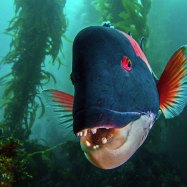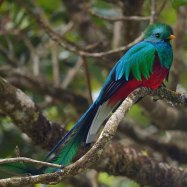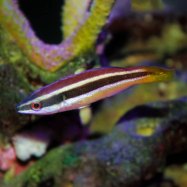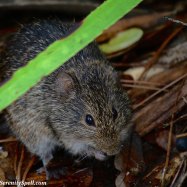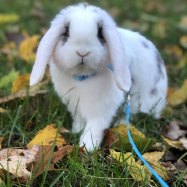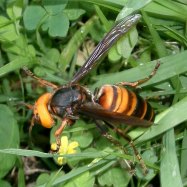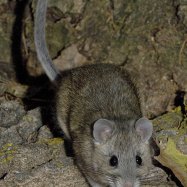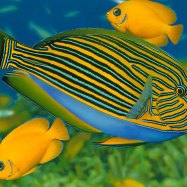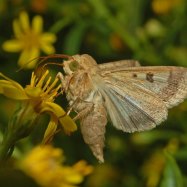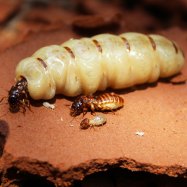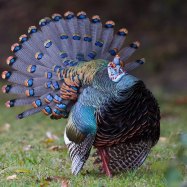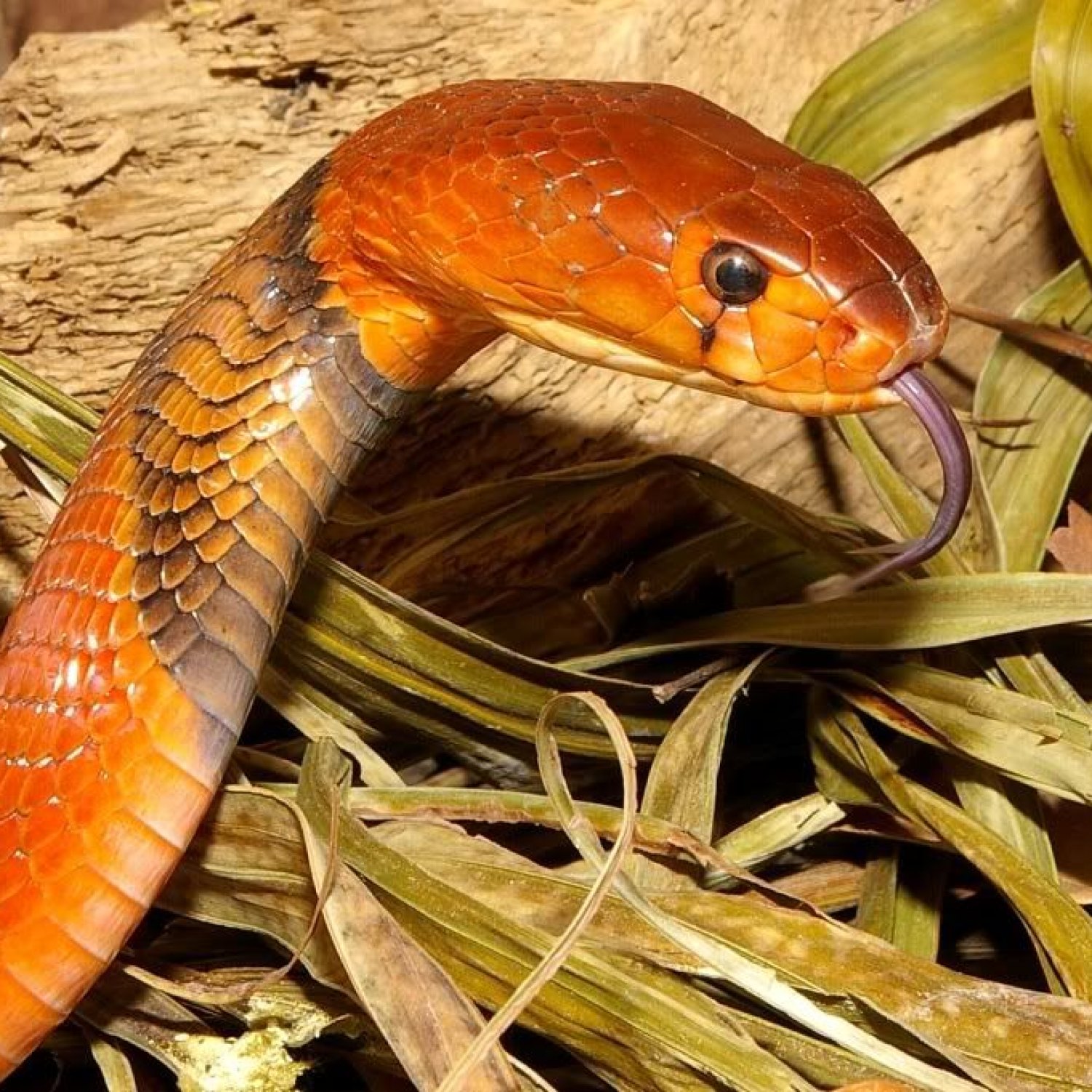
Red Spitting Cobra
1.2 to 1.5 meters
The Red Spitting Cobra is a magnificent sight to see in the savannas and grasslands of Africa. With its striking red color and slender body shape, this venomous snake can grow up to 1.5 meters in length. Though its venom is not fatal to humans, it can cause blindness if it enters the eyes. Remember to keep a safe distance and appreciate this beautiful yet deadly creature from afar. #RedSpittingCobra #AfricanWildlife #Elapidae
Animal Details Summary:
Common Name: Red Spitting Cobra
Kingdom: Animalia
Habitat: Grasslands, savannas, and forested areas
The Fierce and Fascinating Red Spitting Cobra: A Closer Look at Africa's Venomous Reptile
With its striking reddish-brown coloration and deadly venom, the Red Spitting Cobra (Naja pallida), also known as the Red Spitting Naja, is a fascinating yet fearsome animal found in the savannas and grasslands of Africa. This elusive and highly venomous snake is a member of the Elapidae family, a group of snakes known for their potent neurotoxic venom and long, hollow fangs. In this article, we will take a deeper dive into the world of the Red Spitting Cobra and uncover the interesting facts about this underrated species.The Anatomy of the Red Spitting Cobra
As a reptile, the Red Spitting Cobra belongs to the kingdom Animalia, the phylum Chordata, and the class Reptilia, making it a distant relative of lizards, turtles, and crocodiles Red Spitting Cobra. This streamlined snake has a thin and elongated body, with a length ranging from 1.2 to 1.5 meters. Its slender physique enables it to move swiftly through the tall grass and navigate through narrow burrows, making it an excellent hunter.One of the most distinctive features of the Red Spitting Cobra is its vivid reddish-brown or chestnut-brown coloration, which sets it apart from other African cobras. This coloration helps the snake blend in with its natural habitat of grasslands, savannas, and forested areas, providing it with perfect camouflage during hunting and avoiding detection by potential predators.
Dangerous Venom and Feeding Habits
The Red Spitting Cobra is a carnivorous species, meaning it feeds primarily on other animals for survival. It has a varied diet and enjoys prey such as rodents, small mammals, birds, and lizards. Like most cobras, it is an ambush predator, relying on its excellent eyesight and quick reflexes to strike its prey by surprise Rotterman.The Red Spitting Cobra's venom is a potent neurotoxin, which affects the central nervous system of its victim. Although its venom is less toxic compared to other species of cobras, this snake is still highly dangerous and can cause severe injury or even death. It delivers its venom through its long hollow fangs, which can reach up to five millimeters in length and are continually replaced throughout its life.
Habitat and Geographical Distribution
The Red Spitting Cobra is native to the Sub-Saharan regions of Africa, where it can be found in over 15 countries. These include South Africa, Kenya, Tanzania, Mozambique, Zambia, and Zimbabwe, to name a few. This widespread distribution is due to the snake's adaptation to various habitats, making it a versatile and resilient species. It prefers to make its home in grasslands and savannas, but can also be found in forested areas near water sources such as rivers or lakes.Threats and Conservation Efforts
Despite its intimidating and aggressive nature, the Red Spitting Cobra is not considered a threat to humans. It will usually avoid conflict and only strike when it feels threatened or cornered. However, this snake does face various threats, primarily due to human activities such as habitat destruction, road fatalities, and deliberate killings for its skin, which is used in traditional medicine.To protect this significant species, conservation efforts have been put in place in various countries such as South Africa, where the Red Spitting Cobra is listed as a protected species. Education programs have also been launched to raise awareness about these snakes and their critical role in the ecosystem. With these efforts, it is hoped that the Red Spitting Cobra population will continue to thrive in the wild.
The Fear of Spitting
One of the most striking behaviors of the Red Spitting Cobra is its ability to 'spit' its venom when threatened. This unique defense mechanism involves the snake forcefully expelling its venom at its attacker, aiming for the eyes. This can temporarily blind the predator, giving the snake an opportunity to escape. However, this spitting behavior has also earned the Red Spitting Cobra a reputation for being one of the most dangerous snakes in Africa.Contrary to popular belief, the Red Spitting Cobra does not purposely aim for the eyes when spitting its venom. Instead, it is a reflex action that occurs when the snake senses danger. The venom is not ejected in a fine mist, as it is often portrayed, but rather in a stream of thick liquid. The venom can reach a distance of up to two meters, making it an effective defense mechanism against predators.
Humans and the Red Spitting Cobra
As mentioned before, the Red Spitting Cobra is generally not considered a threat to humans. However, human activities and ignorance can lead to dangerous encounters with these snakes. The spitting behavior, in particular, has led to many cases of accidental human envenomation. The venom can cause severe pain, swelling, and even blindness if it enters the eyes.If you do happen to encounter a Red Spitting Cobra, it is essential to remain calm and slowly back away to give the snake an escape route. Never provoke or try to handle this snake, and always seek medical attention immediately if you are spitted on.
The Red Spitting Cobra in Captivity
Due to its striking coloration and unique spitting behavior, the Red Spitting Cobra has gained popularity as an exotic pet. However, keeping this snake in captivity is not recommended for beginners or inexperienced handlers. It requires specialized care and handling due to its dangerous venom and defensive nature. In the wild, this snake is solitary and territorial, so it also does best when kept alone in captivity.To provide the best care for a captive Red Spitting Cobra, owners must replicate its natural habitat as accurately as possible. This includes providing a spacious and secure enclosure with plenty of hiding places, appropriate ventilation, and a suitable temperature and humidity level. It is also crucial to feed the snake a balanced diet and handle it with caution to avoid any spitting episodes.
In Conclusion
In conclusion, the Red Spitting Cobra is a fascinating yet deadly snake found in the savannas and grasslands of Africa. Its striking coloration, potent venom, and unique behavior make it an intriguing species to study. However, it is also a species that demands respect and caution from humans, both in the wild and in captivity. Through conservation efforts and education, we can ensure the survival of these magnificent animals for generations to come.

Red Spitting Cobra
Animal Details Red Spitting Cobra - Scientific Name: Naja pallida
- Category: Animals R
- Scientific Name: Naja pallida
- Common Name: Red Spitting Cobra
- Kingdom: Animalia
- Phylum: Chordata
- Class: Reptilia
- Order: Squamata
- Family: Elapidae
- Habitat: Grasslands, savannas, and forested areas
- Feeding Method: Carnivorous
- Geographical Distribution: Sub-Saharan Africa
- Country of Origin: Multiple countries in Africa
- Location: Savannas and grasslands of Africa
- Animal Coloration: Reddish-brown or chestnut-brown
- Body Shape: Slender
- Length: 1.2 to 1.5 meters
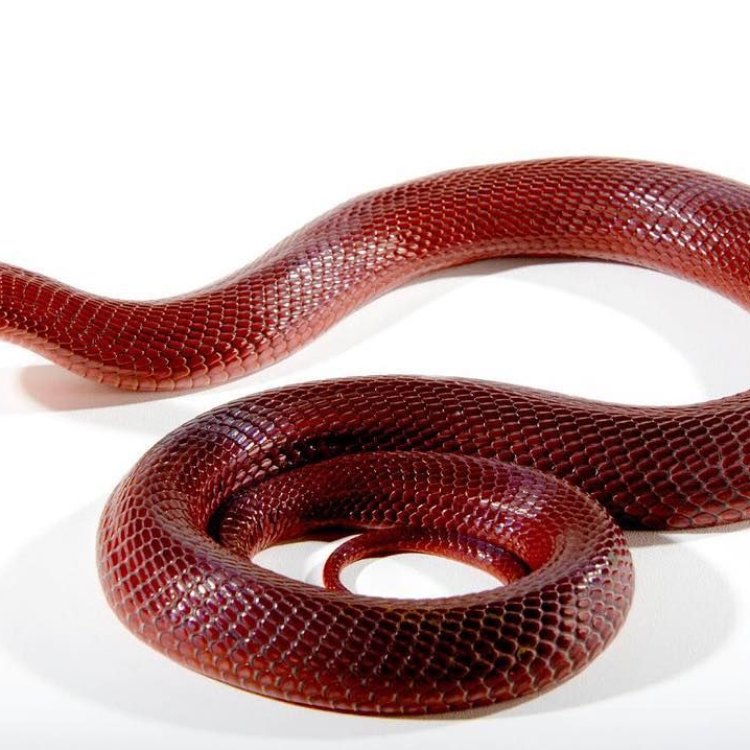
Red Spitting Cobra
- Adult Size: Can reach up to 2 meters
- Average Lifespan: 10 to 12 years
- Reproduction: Oviparous
- Reproductive Behavior: Mating occurs during the rainy season
- Sound or Call: Hisses and makes a loud hissing sound
- Migration Pattern: Non-migratory
- Social Groups: Solitary
- Behavior: Nocturnal and highly venomous
- Threats: Habitat loss and human persecution
- Conservation Status: Least Concern
- Impact on Ecosystem: Plays a role in controlling rodent populations
- Human Use: No significant human use
- Distinctive Features: Hooded appearance when threatened and ability to spit venom
- Interesting Facts: Can accurately spit venom at the eyes of potential threats up to 3 meters away
- Predator: Large birds, mammals, and other snakes
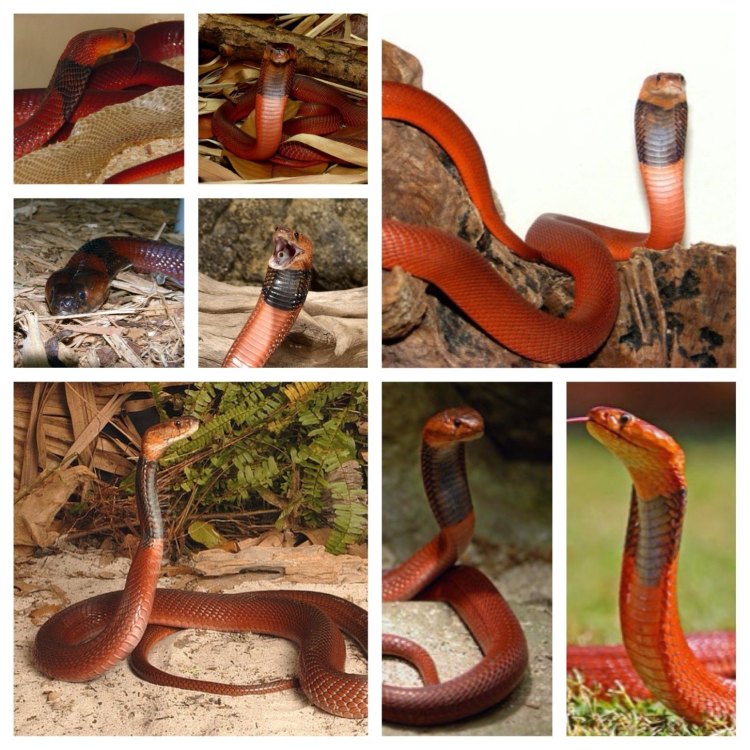
Naja pallida
The Enigmatic Red Spitting Cobra: A Nighttime Hunter and Venom-Spitting Warrior
In the dense and dusty forests of Southeast Asia, there lies a creature with a fearsome reputation. The red spitting cobra, also known as the Javan spitting cobra, is a venomous snake that strikes fear into the hearts of many. With its vibrant red color, powerful venom, and unique defense mechanism, this intriguing species has captured the attention of both researchers and curious individuals. In this article, we will delve into the depths of the red spitting cobra's fascinating features and discover the secrets behind its enigmatic behavior PeaceOfAnimals.Com.Appearance and Size
The red spitting cobra, scientifically called Naja sputatrix, is a large and robust snake that can reach up to 2 meters in length when fully grown. Its slender body is covered in shiny scales, ranging in color from reddish-brown to deep maroon, hence its name. This distinct coloring helps the red spitting cobra camouflage among the surrounding vegetation.One of its most distinctive features is its hood, which can expand when the snake feels threatened. This hooded appearance serves as a warning to potential predators, making the cobra appear larger and more intimidating. When the hood is fully expanded, the red spitting cobra displays a distinct pattern of black and white scales, adding to its already striking appearance.
Lifespan and Reproduction
The average lifespan of a red spitting cobra is 10-12 years in the wild. However, some individuals have been known to live up to 20 years in captivity. Like most snakes, the red spitting cobra is an oviparous species, meaning it lays eggs Rhode Island Red Chicken. The female cobra can lay up to 20 eggs at a time, which she will then guard until they hatch 70-90 days later.Mating Behavior
Mating for the red spitting cobra occurs during the rainy season, typically from December to March. During this time, the male snakes actively search for females, and competition among males can be fierce. Mating is a complex and delicate process for snakes, as they need to ensure that both individuals are in the right position for fertilization to occur. Once fertilization has taken place, the female will go off to find a suitable place to lay her eggs, leaving the male behind.Venom-Spitting Ability
One of the most unique features of the red spitting cobra is its ability to spit venom. When threatened, the cobra can accurately aim and shoot venom at a distance of up to 3 meters, with deadly precision. This venom, which is ejected from special glands located behind the snake's eyes, can cause severe pain and permanent blindness if it enters the eyes of its intended target.However, contrary to popular belief, the red spitting cobra does not have the ability to spray venom from its fangs directly into the eyes of its prey. This behavior is solely a form of defense and is only used when the snake feels threatened.
Nocturnal Behavior
The red spitting cobra is primarily a nocturnal species, meaning it is most active at night. During the day, it can be found taking refuge in burrows, crevices, and dense vegetation to escape the scorching sun. As the night falls, the cobra will venture out to hunt for its prey, which primarily consists of rodents, lizards, and other small creatures.Solitary Lifestyle
Unlike some other snake species, the red spitting cobra is a solitary creature and prefers to live and hunt alone. It is only during the mating season that males and females will come together before separating once again. This solitary lifestyle helps to reduce competition for resources and minimize the risk of territorial conflicts.Threats and Conservation Status
The red spitting cobra, like many other snake species, faces a variety of threats in its natural habitat. Habitat destruction and fragmentation due to human activities are the main threats to this species. Sadly, many snakes are also killed by humans out of fear or retaliation for perceived threats.Fortunately, due to its wide distribution and adaptability, the red spitting cobra is currently listed as least concern on the IUCN Red List. However, continuous monitoring and conservation efforts are necessary to ensure the survival of this species in the wild.
Impact on Ecosystem
The red spitting cobra plays a crucial role in controlling rodent populations, making it an important part of its ecosystem. Without the cobra's presence, rodent populations could quickly spiral out of control, leading to a cascade of effects on the environment and other species. This further emphasizes the importance of preserving this unique species and its role in maintaining balanced ecosystems.Human Use
Unlike other species of cobras, the red spitting cobra has no significant human use. It is not commonly found in the pet trade, and its venom is not as potent or sought after as other cobra species. As a result, this species is not actively exploited by humans, which is a fortunate circumstance for the survival of the red spitting cobra in the wild.Predators and Interesting Facts
The red spitting cobra is a formidable predator, but it also faces threats from other animals in its ecosystem. Large birds of prey, such as eagles, are known to prey on these snakes, as well as other mammals, such as mongooses and civets. Other snakes, such as king cobras and Russell's vipers, are also known to hunt red spitting cobras.Interestingly, despite its potent venom and fearsome reputation, the red spitting cobra is generally a shy and non-aggressive species. It will only use its venom-spitting ability as a last resort when it feels threatened.
One particularly interesting fact about this species is that its scientific name, Naja sputatrix, translates to "spitting cobra" in Latin. This name is a testament to its unique ability that has captivated the attention of researchers and snake enthusiasts alike.
In Conclusion
In the depths of the Southeast Asian forests, the red spitting cobra reigns supreme as a skilled hunter and formidable warrior. Its vivid red color, hooded appearance, and venom-spitting ability have earned it a fearsome reputation, yet its true nature is one of a shy and solitary creature. While it faces threats from habitat loss and human persecution, the red spitting cobra plays a crucial role in its ecosystem, ensuring the balance of its delicate ecosystem. Its unique features and fascinating behavior make it a truly unique and enigmatic species that deserves our admiration and protection.
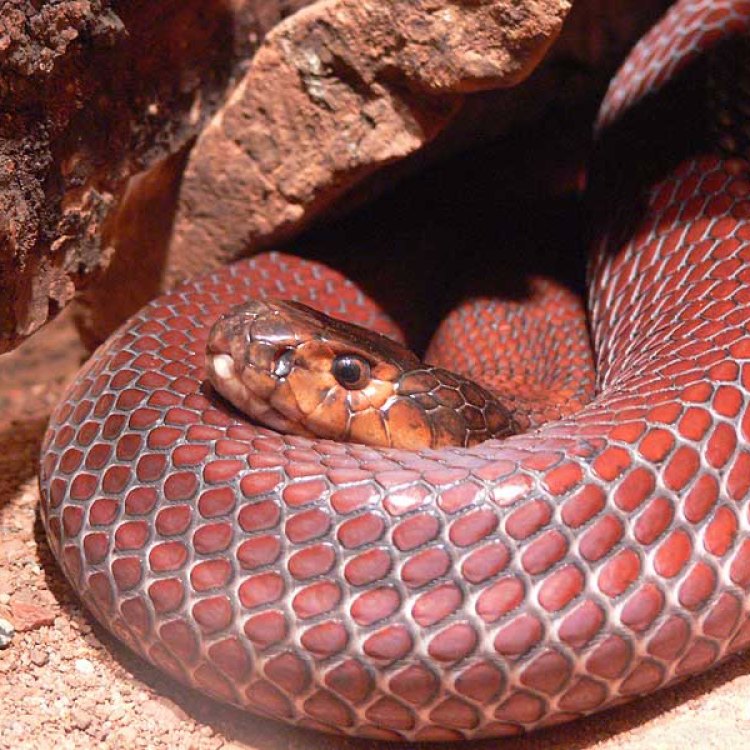
The Fierce and Fascinating Red Spitting Cobra: A Closer Look at Africa's Venomous Reptile
Disclaimer: The content provided is for informational purposes only. We cannot guarantee the accuracy of the information on this page 100%. All information provided here may change without prior notice.

